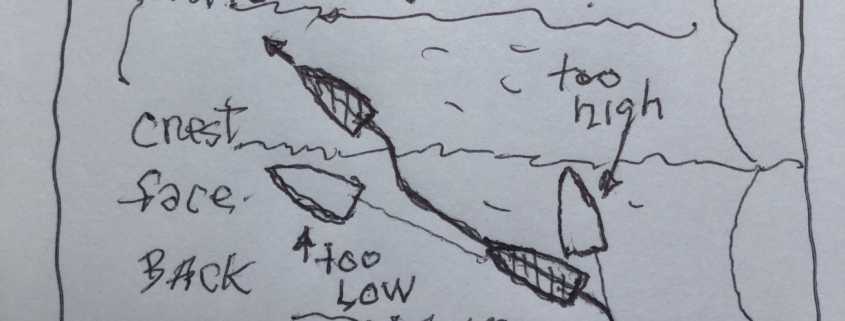Sailing The Chop
By Gordy Bowers
I classify waves by height, length, speed and shape. Each separate sea state requires a different combination of your basic skill techniques — weight position movement, sail trim, and steering. Below, the following wave and wind descriptions are discussed:
1. Flat water: height 0 to 6 inches, wind 0 to 9 knots, and small ripples on the surface.
2. Chop: height 6 to 12 inches, wind 10 to 16 knots.
3. Waves: height 1 to 2.5 feet, wind 16 to 20 knots.
4. Big waves: height 2.5 to 6 feet or more, wind 16 knots and up.
5. Swell: old waves on the Great Lakes or ocean are no longer driven by existing wind.
6. Slop: powerboat waves that approach from random directions.
For lake sailors, Chop is a problem on the leeward half of the leg. To study the waves closely before a race, I recommend stopping close to the starting area. Put the boat on a beam reach with your sail luffing. Choppy waves are 6 to 12 inches high and 5 to 7 feet long. This confused chop varies in direction, from 10 to 20 degrees, and height from 6 to 12 inches. Steep waves will often come in sets of two, three or four, followed by a very flat section that will build up to another set of big waves.
The degree a wave’s height and length will cause your boat to pitch, and to slow down, will depend on the length, weight, speed and bow shape of your boat. Small, light boats like Optimist, Laser and 420 can pitch violently up and down in steep chop. The MC, C and Melges 15 Scows, and Yngling keelboats, will pitch less but can be slowed noticeably. E and A Scows are longer at waterline and heavier, so they will not pitch, but can be slowed by wave friction.
The fast sailor uses all sides of the largest waves. Sailors of small boats, like Opti, Laser, 420 and Melges 15, should study wave shape. Think of them as hills with sloping edges on the front, back, right side and left side. Then judge what wave height will slow your boat.
When looking at the face of the individual big wave ask yourself whether the width of the white crest is long or short? If the white crest is coming right at you, attack by steering bow down 5 to 10 degrees, lean aft, hike out, ease the mainsail to maintain the correct heal angle, and cross the wave at an oblique angle. If the main luffs excessively, ease the jib 1 or 2 inches, to quiet the main and rebalance helm pressure. With speed and angle your boat will pitch less in the next one or two big waves. Making your boat your heel up 5 more degrees will let the rapidly moving white water pass with less resistance.
Once you see and understand the wave that will pitch your boat, you can steer to avoid or attack the big waves. Try to avoid the largest waves by heading up or down slightly, and leaning aft to lift the bow.
When going into rough sections you need to steer slightly away from the wind to keep speed. After the last big wave crest has passed, ease main to head down with less weather helm pressure and build speed. However, in the following flat sections you can point higher, to make up for the lost height. Trim the mainsail harder, and set vang tension for the flat spots. In the big wave sets, an overly flat main is slower.
Your “go fast” technique is to efficiently shift from speed mode to point mode, and back, as waves change, using your basics of weight movement, sail trim and steering.
Go out, experiment, learn, and enjoy the Chop!

